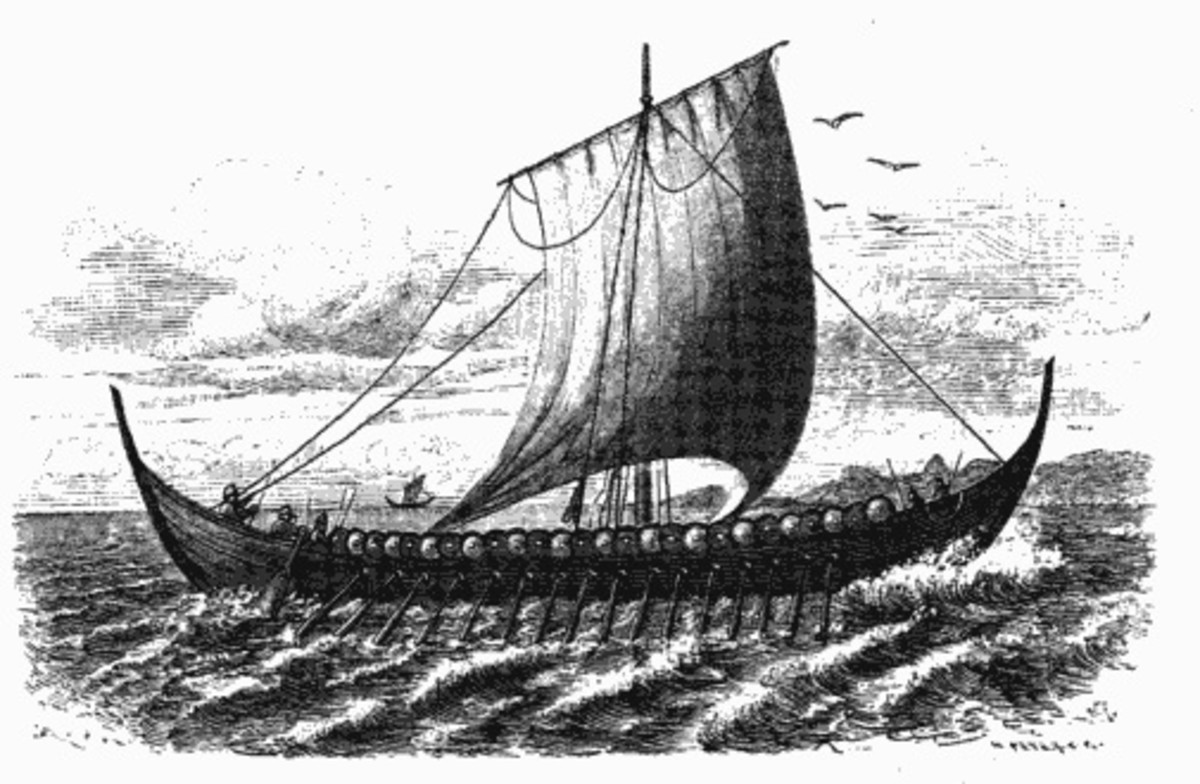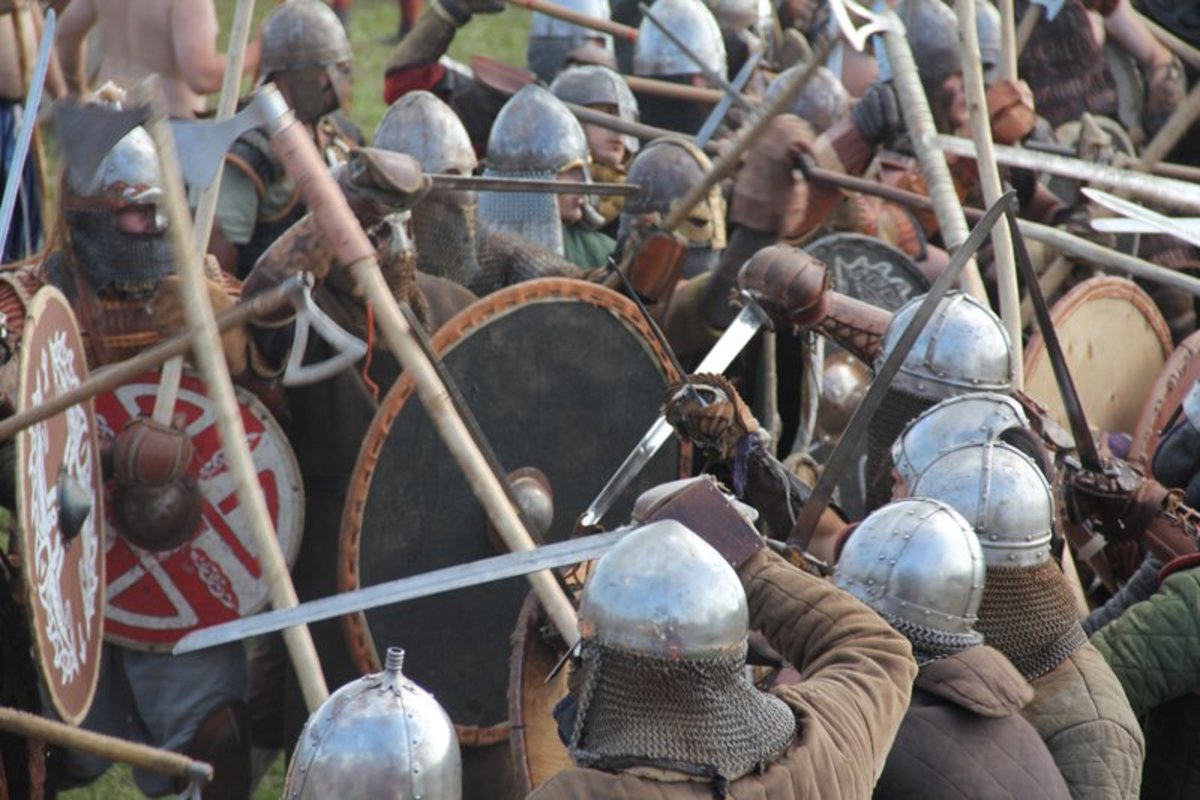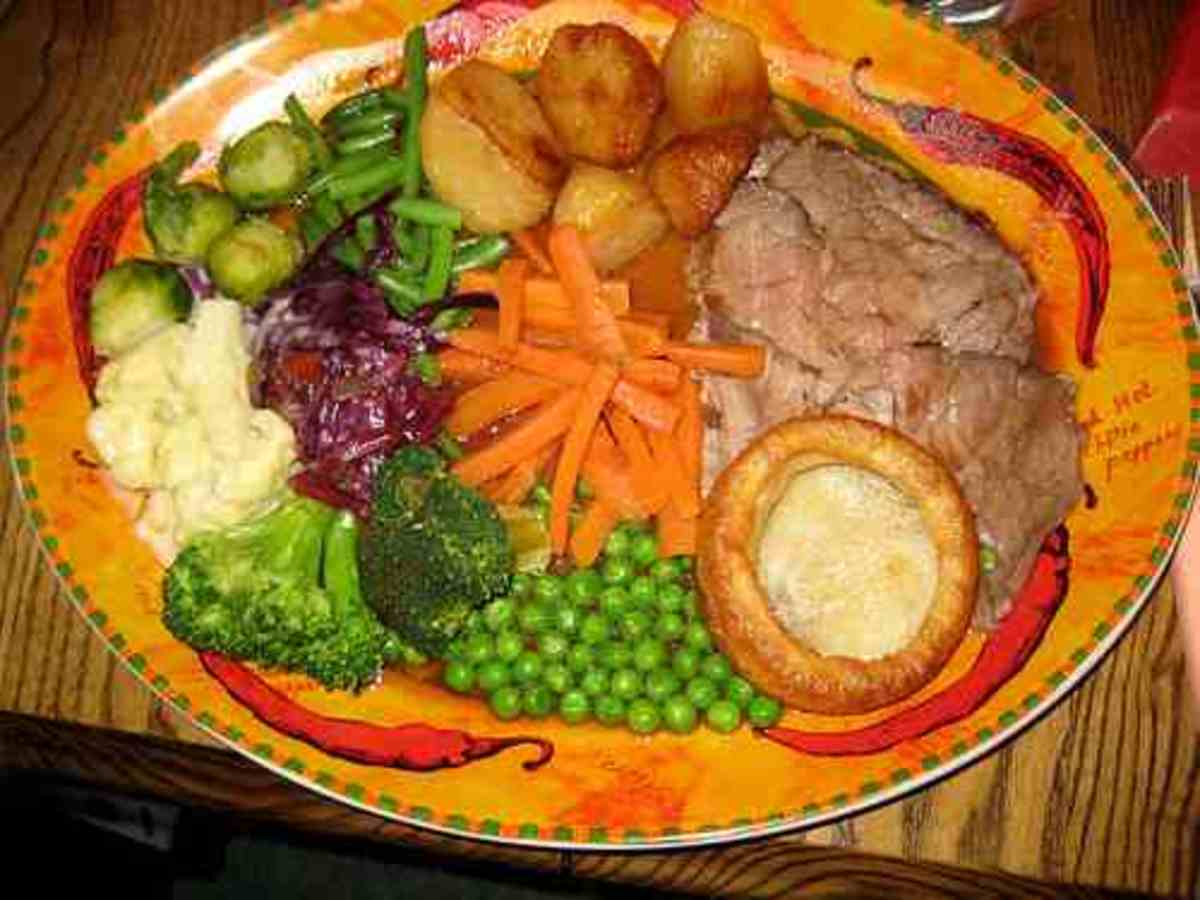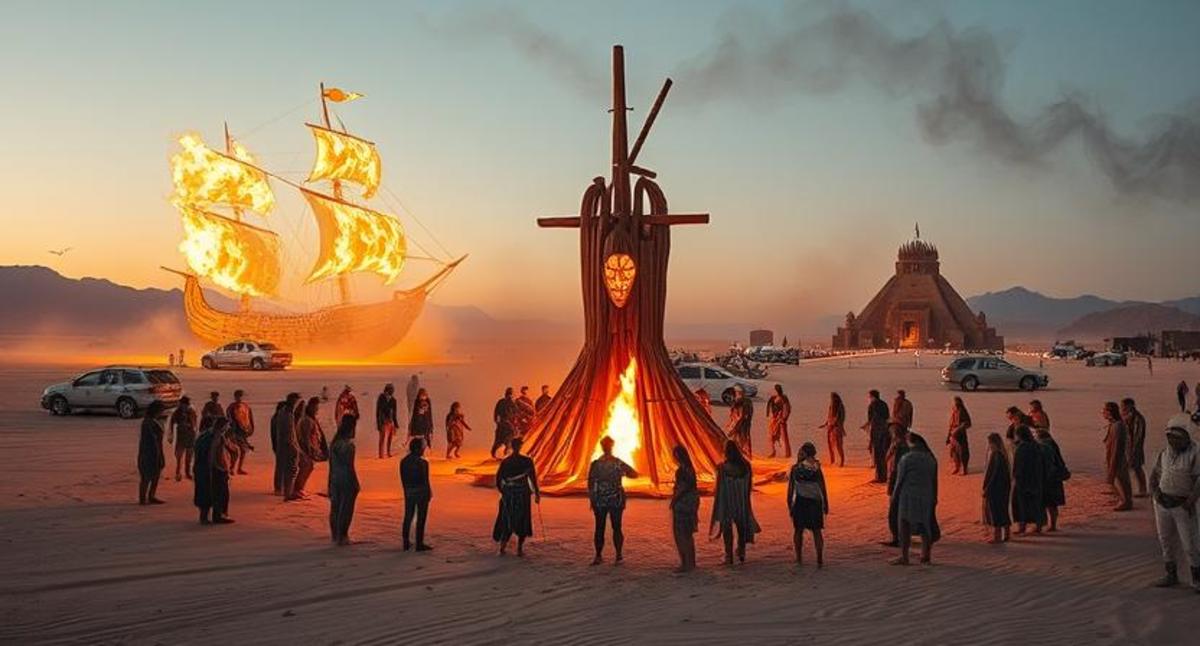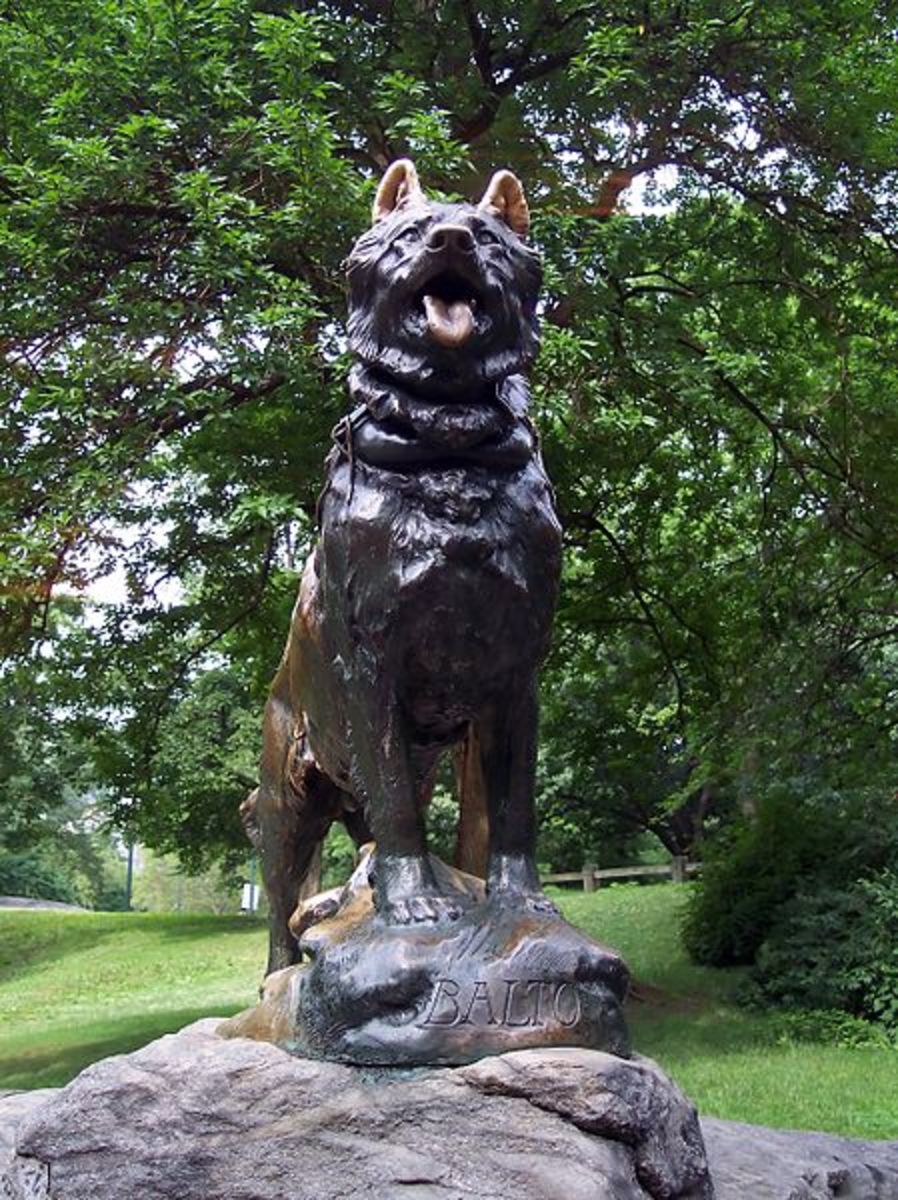- HubPages»
- Books, Literature, and Writing»
- Commercial & Creative Writing»
- Creative Writing»
- Humor Writing
Viking Carnivores Open Pit "Big Meat" BBQ
Two Hours into the "Big Meat" Barbeque
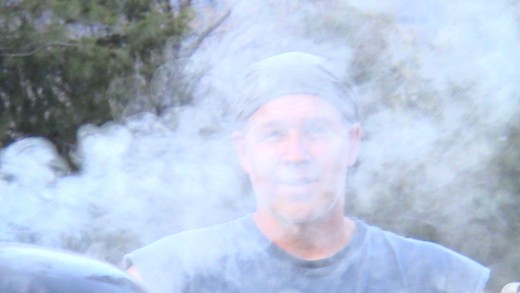
Barbeque Grills
Big Plum Barbeque
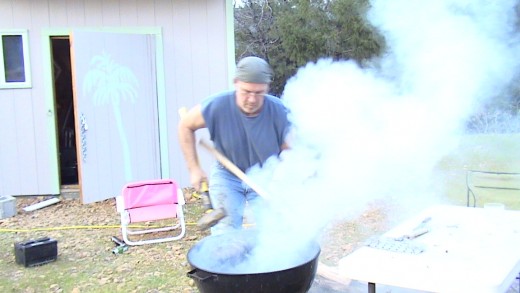
Starting the Open Pit Blaze
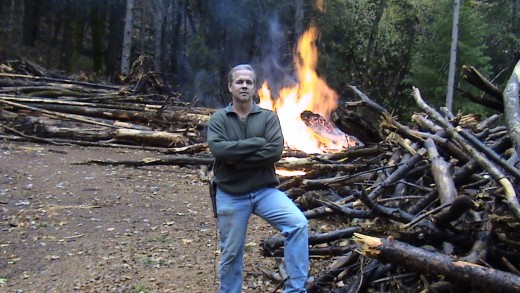
Viking Carnivore "Big Meat" Traditional Cooking Techniques Exposed
Many moons ago I was inspired to barbeque during a winter snow storm near the Oregon coast not so different than my many Summer Viking barbecues in Northern California. That one snow day twenty something years ago, coined my tradition of barbequing “big meat” like a Viking in extreme conditions. The rest is history and the “big meat” barbeque tradition I carry on satisfies the most insatiable savage appetites. I cook “big meat” Viking meals typically during two seasons, in two different locations. The two seasons are winter during the North West Oregon snow blasts and ice storms similar to Northern Europe weather trends; also during summer months under the blistering sun’s rays of Northern California.
One methodology of “big meat” smoky BQ is performed under an open garage using a Weber barbeque, while the other is performed over an open pit campfire on grill rack with a Weber cover, or Weber BQ unit. Either one of these two geographies provides the right atmospheric aroma smoke movement and smells.
The two seasons are worthy “in my opinion” of a traditional Viking Carnivore “big meat” festivity for the protein deficient. This was and still is the staple of Nordic and European coastal Viking Carnivore celebration; “at least in my neck of the woods it is.” I use unconventional and traditional Western cooking methods and techniques with a Viking theme that originated in the great North West kicked off many years ago under my garage on a snow day. I’ve been at it ever since perfecting my “big meat” barbequing skills.
There are big differences as far as the two traditional “big meat “cooking methods are concerned. Definitely “big meat” barbequing is totally different then your fast gas, or briquette cooked tenderloin, T-bone and New York steak, etc. Both summer and winter Viking cooking methodologies will now be covered.
The no wind condition is important during the summer barbarian feast as opposed to the winter celebration. Why is this? Because the slow cooking technique allows one to also enjoy the day while anticipating the good eats. This is a great time to participate in a gaming session: horseshoes, Frisbee, nurf football while consuming quality grog under heavy blistering sun rays and not so much standing next to a 250-350 degree heat source. Often, the nurf is thrown over the horseshoe Vikings pit area to make things more interesting for the elder spectator vikings.
Also, during the perfect BQ Summer smoke off, the lid-dampers are closed enough to create a slight suffocation of premium oak and Manzanita, or mesquite once the fuel is amber hot. You see a modern day Viking doesn’t envision his homeland off of some Nordic, or European coast line. But can find his homeland comforts by recreating in a festive and game fun area with good friends and of course the aroma smoked environment where the smoke lays heavy at ground level. Barbecue works great with a no wind condition. The smoke envelopes the grounds with a cherry bomb effect that is real cool. It is so cool it pays “big dividends” in ways that only those that have experienced it can totally relate.
Why Oak as the fuel source? It’s simply the best smoking wood in my opinion. It burns hot and long and is plentiful in our native forests. Manzanita is also a hardwood with great flavor (a bit stronger smoky taste, less sugar flavor than oak). Manzanita and mesquite also compliment oak wood smoking by way of smoker’s chips with tasty rich mixed flavors.
Now during the winter BQ smoke off, a Viking Carnivore is all about warmth and damper control of the barbeque with lots of wind to properly propel the aroma and plenty of fine grog to enhance cheer. This way it’s easy to signal your near Viking tribes you take your “big meat” cooking and festivities serious. Like Scandinavia it is better to have this celebration during a heavy snow, or freeze. Temperatures should range in the high teens to below freezing with a steady 8-12mile per hour wind with blizzard is “spot on” if you can get it. Why? Because this adds to the excitement of this mystic celebration, pays bigger dividends esthetically and as the delicious smoked “big meat” aroma travels throughout the village
This thickened white smoked oak plum beacons many to imagine and wonder how good this slab of meat would taste. It also brings comfort to empty bellies that will soon fill with the most fantastic tasting Protein in the world. Compliments from the elders tell you, you've met expectations. This builds the Viking ego immensely.
Simply by using traditional Western smoking methods the Viking festivities while children play in the snow can truly be experienced by all. This is not a traditional Western celebration but a modified Viking feast. Aroma aeration from my hooch is left wide open to the village tribes for proper air turbulence convection and distribution of fine aromatic smells. All of this occurs as I expertly use my special knowledge in “big meat” barbequing for my fellow Viking Carnivores.
Yes, we will all partake often in this celebration of life and family brought together through “big meat” cook offs “with drink of grog.” The neighboring tribes are only left to ponder, “There must be a Viking feast over at the tribal hooch, “in my case, in my garage.” Or, “those guys are at it again, smoke is pouring out the garage,’ maybe the hooch is on fire?” “I can guarantee, neighboring Vikings will check it out to ensure there is no fire while working their way in for a look.
Smoke from an oak wood burning barbeque puts out smells like no other and a lot of it for long periods of time. As a matter of fact I’ve been known to stimulate olfactory nose receptors for miles away. My Viking feasts are almost legendary regardless of whether I celebrate the winter, or summer “big meat” cook off tradition. I still have one Viking brethren that has not partaken in the festivities for twenty years. But he always says when he sees me, says, “do you remember how good that “big meat” tasted out of your garage during that snow storm? What was it a 30lb roast? Holy cow, I didn’t know a roast could melt in your mouth that way, let alone fit in your barbeque. I simply must drop by when you do that again, “let me know!” Then he’ll say, why do you cook this way in these extreme weather conditions?” My reply, “a Nordic Viking wouldn’t have it any other way.”
Now, I mention grog. Since we are modern day Viking warriors, there is a huge interpretation of exactly what grog is, or should be. However, you should know the traditional grog in my village is wine drank out of a goat skin stomach. “Yah, you heard me right,’ I know, you’re saying, are you kidding me?” My answer is “yes I am.” How fun was that? But, if I had a goat skin stomach, I would consume a fine Merlot, not too sweet, not to dry. Some Viking want-a-bee will fill their cup with port wine. This is a big mistake and un-Viking like behavior. The same mistake can be made with a full taste beer. It is too rich and filling and will lessen your ability to consume mass portions of “big meat,” and quite frankly, the Viking want-a-bee may be out for the count early on in the celebration.” Did I mention we also drink our grog out of Viking mugs and goblets? “Why, yes we do, which will be covered under appropriate Viking utensils when invited to Viking Carnivore “big meat” meals.
To ensure the occasion goes off without a hitch, you must find the right Viking utensil and clothing wear. The clothing can be anything that looks to be cool Viking stuff. At a minimum, you have to have a helmet with Viking horns, or something of that nature. If you can’t find one with horns any Viking leather-fur cap or helmet will work. The most important item you’ll want to take with you is an impressive knife and fork as this will be your only eating utensil. No plates, or napkins will be provided. Ensure you have sleeves and a loin cloth over your belt. I know what you’re thinking right now, “don’t be ridiculous,’ of course your wearing pants!” There is a purpose to this; one of which the loin cloth identifies your tribal village and also dubs as a napkin.
All utensils are stylishly attached to your big leather Viking belt, or slung over your neck, resting on opposite shoulder. Kind of the way you would carry a battle axe or shield into battle. I highly recommend a long handled skewer fork. And no less than a ten inch hunter’s knife blade affixed to an antler’s handle if you can swing it. The bigger the hardware the more impressed your fellow Vikings will be and filled with admiration for your tools.
The size and appearance of the goblet also needs to draw respect. Gaudy and medieval is very good! By the way, Viking women of the festivity can out shine a Viking male warrior simply by out garbing and out charming all of those around them. Viking warriors must also carry a jesting and non-belittling persona, to lighten mood and entertain while welcoming all around them. I’ve seen Viking women reduce a Viking warrior to rubble when getting out of line. You don't want that! So be prepared to go into battle with the right disposition, or it’s best to stay back at your tribal hooch, or sleep it off under your personal thatch.
Now that I’ve gone over the basic Viking festivity formalities and dress code, it is now time to learn how to properly create the right aroma filled air and succulent tasty “big meat” barbecue. The first and most important ingredient in preparation for “big meat’ cooking is not briquettes,” but instead oak wood. The starter pit, whether over an open pit, or Weber must be started with very dry oak kindling
This takes patience for which “this Viking” rarely has. I use a turbo torch with MAPP gas. Yah I know, I cheat to get to the Viking fun festivities quicker. What can I say, “I’m a modern day Viking warrior field trained in the fine art of deception and field expediency,” moving onto the next mission without haste.” However, I can do without a turbo tourch, for which all should learn how to do.
Ok, you work the fuel core into hot ambers while adding bigger pieces of oak “using a quartered wood stump into a teepee layout, while feeding the kindle.” Once you get 50% of your core cooking wood amber red, it’s time to create a cool core area centralized with a hot parameter around it. You’ll take the wood and push it to your outer perimeters of your BQ side wall. If over an open flame, I recommend bringing a grill screen and BQ Weber Lid, or something similar to capture the heat and smoke. The Weber BQ technique is similar to the open pit BQ grid technique for fuel layout and cooking. You’ll support the grid over pit with non-popping scale rocks [use big dense bed rock if you can find it], or big back logs that won’t burn down with the parameter cooking fuel. Rocks are better to use if you can get a non shale-type harden rock. Granite is best. If no rocks, you'll have to dig down into the earth no less than 10." Parameter heating built right allows you to control the heat source better.
Once the center core temp reaches 250-325 degrees, the “big meat” is ready to go on the grill. Put the “big meat on the grill.” Why do I keep referring to the meat as “big meat?” Because it is a “big ass” piece of meat, usually over 10 lbs! And I always outlay chicken breast, fish and thighs on the grid over direct heat for quick tantalizing morsels that can be easily skewered by Viking utensils at will. Vikings need something quickly “gnaw on” while waiting for the main course. This also slows down the consumption of grog. Otherwise the Vikings will go barbaric on something, or someone for which tribal security and prison holding may be required!
Vikings also need some vegetation in the diet. Corn in the husk is the barbarian preference. Throw the entire non-husked corn around the “big meat” on the grill. Do this once the chicken is done and meat is half way cooked. Turn corn in husk until husk is scored well all the way around. I’ve stacked up to 8-10 pieces of corn while rotating around the “big meat and morsels.”
Corn consumption technique is very dependent on the Vikings loin cloth garb. The loin cloth doubles as a napkin and hot mitt for consumption of mass corn. Simply pick up corn with loin cloth, husk the corn, use Viking utensils to add your favorite spice and lard, consume. Also, be sure to plunder, or barter for the biggest blooming sweet onions you can find. Use a 10” cast iron shallow pan for best onion cooking over pit. Cook the onion whole, pour Greek, virgin olive oil over the top, season with specified Viking spices. Wait till onion falls apart on its own, then consume with Viking utensils.
What is the Vikings “big meat” of choice? This Viking looks for uncut “big meat” oxen, buffalo, pigs, mutton you name it, we cook it. But mostly huge tri-tip beef cuts (sometime 2-3, 5-8pounders). I have been known to cook 20-26+lb roasts-turkeys, using my slow 6 hour Viking BQ technique. This is another story.
A word of caution, when cooking on an open pit a seasoned Viking pyrotechnic expert should take command of this area. Much more attention, focus and experience is required not to overcook the meat, or sear a young Viking warrior unnecessarily. However, if a burn does occur, make sure you have at hand a Vikings first aid ointment of Tea Tree oil, alovera gel and gauze. Cover burn with oil first, then apply gel, cover with gauze and continue on with the festivities. Non life threatening Battle wounds are something to brag about with your fellow Viking Carnivore that will fuel stories of legend for young savages into the next century and beyond!
I digress. A 24 inch grid lift “minimum” above the heat source over an open pit fire is wise. Heat control over an open pit is maintained by ensuring a non direct-heat core parameter like the Weber barbeque methodology. By using the Weber lid “or something similar” over an open pit with grid, you will have to still manage damper lever on lid to adequately capture the natural oak smoke wood sugar to adequately lock the juices in. Always, slow cook simmer over an open pit, otherwise your Viking brethren may go barbaric on you if you serve them dry oxen, or mutton! You can accomplish excellent “extreme big meat” barbeque with a large skewer over an open pit. However, this is another story which requires just as much expertise as burying your meat underground with hot coal engulfing the “big meat.”
Regardless of pit, or Weber barbeque cooking technique, ensure when you lay down the meat, no flame directly touches it. Cover the meat and let it sear for minutes at a time. Let it simmer longer. Once you hear the juices begin to drip, ensure bottom dampers of barbeque are reduced 25% open after the first 10 minutes. From the get go, the top air dampers are one quarter open on Weber lid and closed almost all the way when a grid over an open fire pit is your cooking style.
Open pit requires more accurate fuel stoking with wind as your biggest challenge if this technique is used during winter months. These techniques if done right will hold temps around 250 – 325 degrees under the lid once perfected. The perfect “big meat” proper cooking sequence is base on heat, thickened white oak smoke appearance and smell penetrating the airways, as well as meat color, tenderness and dripping juice frequency. Properly cooked “big meat” should have a pink glow throughout the entire inners, very juicy, while the outer surface appears to be a caramelized reddened honey glazed look. This is how a “Master Viking Big Meat Chef satisfies the Supreme Viking Chieftain." But before the consumption, let’s review the ritual of cooking with a little bit more detail.
Once the smoke thickness encroaches onto the festivity grounds, enact the following Viking ritual to reignite the fire-heat-smoke sequence. Take the lid off, turn the meat, season the meat, swing the lid back and forth over the hot ambers to reignite it by injecting oxygen enriched air from the “swinging of the lid with grog in the other hand, and cover.”
Ensure you don’t overdo the grog, while you perform this ritual or ashes will adhere to your meat and you may also spill your grog! Viking women hate ash in “big meat” and the Viking men hate it when you waste grog! “Balance in everything you do or you’ll have some price to pay.”
There will be so much thickened smoke once the fuel reignites; you’ll have to be an air intake “one-eyed Willie” expert to maneuver around this eye assault. This ritual is done repeatedly and can be dampened down for long periods of time to create stronger smoked flavor, tenderness and abundance in flavorful juices and relief from the one-eyed Willie effect.
Do not cover Viking “big meat” with foil! This will ruin the flavor and you cannot properly cook the meat if you can’t see the color of it, or cut into it easily to check it out with your Viking big knife when gnawing on samples. Sample before you serve the Supreme Viking Chieftain or you may get an ear load.
The secret of keeping the juices in “big meat” cooking methodology stems from the fact that oak creates a honey-red wood sugar glaze on the outer surface of the meat. If cooked right, it’s like wrapping it in a natural sugar sealed coat that keeps the juices in. So, if your meat is dripping too much, the heat source is too hot and the natural sugars are not adhering to the outer surface of the “big meat. If this is the case our meat will dry out like leather. You should hear only a drip here and there throughout the entire cooking process.
I’ve spent 2-3 hours cooking a 10lb piece of meat to perfection. Note: If you have to add more wood, you need to be ready for this. I use a large steal Viking spatula to lift the grilling grid with the meat on it and add wood with the other hand. If this is too difficult enlist a fellow Viking, they love to help while balancing grog in the other hand. Plus they think this act attracts the attention of the “single” Viking women! which also builds their ego.
Now to add additional smoke flavors to the meat, after the meat is cooked one third way through, add water soaked mesquite, or Manzanita chips to the hot oak ambers. The smoke will engulf the air as well as saturate the meats outer pours with additional smoky flavors beyond your taste buds expectations. The only spices that can be used is a tradition salt and pepper glazing. Do not use barbeque sauce, or marinate the meat. This will take away from the Viking feast experience and wonderful complex sugar smoky flavors absorbed by the “big meat.”
I have however upgraded the seasoning selection which vastly improves the taste based on Viking bud preferences. That seasoning is Montreal steak seasoning found at your local market. It also adds to the aroma air-smoke drafts with greater impact on olfactory senses. I find no matter what the weather condition, or season; the best Viking meat is cooked “at first” over an extremely hot flame with a hollow core while dampening air flow, then reducing heat, “sear-simmer method for long periods of time, simmering longer then searing. This tends to cook the meat with a thick red sugary glaze from the wood fuel while retaining much of the juice inside the “big meat.”
Now you have a good ideal how to create the perfect Viking barbarian feast. I must warn you, your BQ will be a hit and the local villagers may be jealous of your new found “big meat” barbeque talents and tasty creativities. So you better think about inviting them over to keep the piece in the village if they keep sticking their noses out, or stick your nose out at them, “your choice.”
Also, be careful how much grog you drink. Your Viking Queen won’t be happy with you if you get out of control regardless of how smashing the barbarian “big meat” festivities went over. This celebration is about family and good friends celebrating life together. Warning, this celebration is not for the faint heart with proper dining etiquette, you must make considerations for the timid, but I highly recommend against this modification in plans as it will take away from the Viking “big meat” festivities.
Be sure to plan accordingly with outdoor activity for all! Whether it’s blistering hot or blizzard cold; entertainment is key to this cultures festivity success. “I highly recommend” If you have battle axes and knives throw them at a wood stump target. Make sure it’s not a live target! Now go out eat “big BQ meat, drink grog” and celebrate befitting as the Nordic savages once did!



